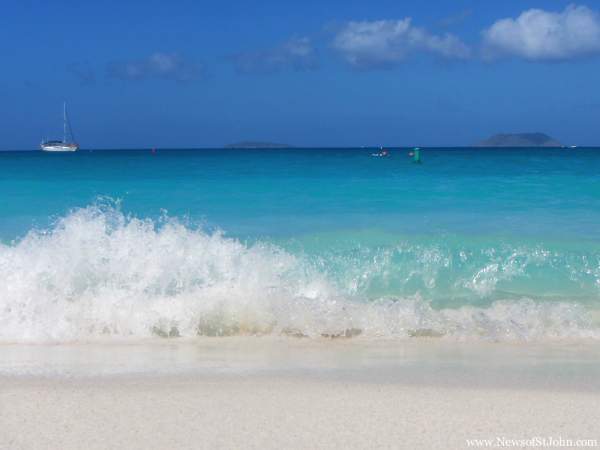
Yesterday I received an email from Brian Naess. Brian teaches a coral reef ecology class at the University of North Carolina at Chapel Hill and is a frequent St. John visitor. Each Spring Break, Brian takes students to the island to snorkel and study the reefs. Knowing that a lot of you read this blog daily (and a big thank you to all of you who do), Brian asked me to pass along a message regarding the sunscreens we’re using and the types we should use. Here’s what he wrote:
A brand new study has shown how dangerous the chemical oxybenzone is to coral. Oxybenzone is a chemical found in most of the sunscreens out there, and has been shown to damage the DNA and act as an endocrine disrupter of coral. Oxybenzone has also been shown to induce coral bleaching.
“The study discovered that the arguably lowest concentration to see a toxicity effect was as low as 62 parts per trillion – equivalent to a drop of water in six and a half Olympic-sized swimming pools. The highest concentration of oxybenzone was seen in Trunk Bay in the Virgin Islands National Park at 1.4 parts per million. The average concentration for other Virgin Islands National Park coral reef locations was about 250 parts per billion.”
We need to get your readers to switch to sunscreens that don’t have oxybenzone in them.
Most of the zinc/titanium oxide sunscreens should be fine. This is a good resource for people who want to find good sunscreens: http://www.ewg.org/2015sunscreen/
Most people don’t like the zinc/titanium oxide sunscreens, ’cause they are sunblocks and stay on top of your skin. So, when you get out of the water, you look all white! I totally sympathize with that. Unfortunately, the US is way behind the curve on sunscreens. There are many European brands that offer better sun protection in a formula that absorbs into your skin, goes on clear, and isn’t greasy. They are really expensive, though (sometimes around $30 for a small bottle!), and usually not available in the US. There’s a long story behind the regulation of sunscreen in the US…
The best solution is to limit the amount of sunscreen that you apply in the first place by wearing clothing while you swim. Rashguards, wet suits, and dive skins all offer good sun protection without having to goop up before you get into the water.
So I was curious about how reef-safe the sunscreen I use daily is. And sadly, it’s one of the worst ones. Here’s a list of the worst offenders according to the Environmental Working Group:
11 Worst Spray Sunscreens: These sunscreens are aerosol sprays with SPFs above 50+ and the harmful additives oxybenzone and retinyl palmitate.
- Banana Boat Clear UltraMist Ultra Defense MAX Skin Protect Continuous Spray Sunscreen, SPF 110
- Coppertone Sport High Performance AccuSpray Sunscreen, SPF 70
- Coppertone Sport High Performance Clear Continuous Spray Sunscreen, SPF 100+
- CVS Clear Spray Sunscreen, SPF 100
- CVS Sheer Mist Spray Sunscreen, SPF 70
- CVS Sport Clear Spray Sunscreen, SPF 100+
- CVS Wet & Dry Sunscreen Spray, SPF 85
- Neutrogena Fresh Cooling Sunscreen Body Mist, SPF 70
- Neutrogena Ultra Sheer Body Mist Sunscreen Spray, SPF 100+
- Neutrogena Ultra Sheer Body Mist Sunscreen Spray, SPF 70
- Neutrogena Wet Skin Sunscreen Spray, SPF 85+
12 Worst Sunscreen Lotions: These sunscreen lotions claim SPFs above 50+ and contain oxybenzone and retinyl palmitate.
- Banana Boat Sport Performance Sunscreen Lotion, SPF 100
- Coppertone Sport High Performance Sunscreen Lotion, SPF 100
- Coppertone Sport High Performance Sunscreen, SPF 75
- Coppertone Sport Sunscreen Stick, SPF 55
- Coppertone Ultra Guard Sunscreen Lotion, SPF 70+
- CVS Sport Sunstick Sunscreen, SPF 55
- CVS Sun Lotion Sunscreen, SPF 100
- CVS Sun Lotion Sunscreen, SPF 70
- Neutrogena Ultra Sheer Daily Liquid Sunscreen, SPF 70
- NO-AD Sunscreen Lotion, SPF 60
- NO-AD Sunscreen Lotion, SPF 85
- Ocean Potion Protect & Nourish Sunscreen Lotion, SPF 70
11 Worst Sunscreens for Kids: These terrible kid and baby sunscreens have at least three strikes against them: 1) oxybenzone, 2) retinyl palmitate and 3) SPFs above 50+. Two have a fourth strike: they’re aerosol sprays that can harm sensitive young lungs. Convenient? Yes. Good for kids? Absolutely not.
- Banana Boat Clear UltraMist Kids Max Protect & Play Continuous Spray Sunscreen, SPF 110
- Coppertone Kids Sunscreen Lotion, SPF 70
- Coppertone Kids Sunscreen Stick, SPF 55
- Coppertone Kids Wacky Foam Foaming Lotion Sunscreen, SPF 70+
- Coppertone Water Babies Sunscreen Lotion, SPF 70+
- Coppertone Water Babies Sunscreen Stick, SPF 55
- Equate Kids Sunscreen Stick, SPF 55
- Kroger Baby Sunscreen Lotion, SPF 70
- Kroger Kids Sunscreen Lotion, SPF 70
- Neutrogena Wet Skin Kids Beach & Pool Sunblock Spray, SPF 70+
- Up & Up Kid’s Sunscreen Stick, SPF 55
News you can use today folks.
Brian will be back on island with his students from March 10th through March 19th. Earlier this year, they filmed an amazing underwater video – one of the best I’ve ever seen. Click here to check it out.
Looking for a quality reef-safe sunscreen? Check out our ultimate guide to the best reef-safe sunscreens.



It would be good to list less harmful sunscreens for people as well. Without an alternative most people will not make the simple choice of choosing a different sunscreen!
Thanks for this. We spend February on island and I’ve been using one of the offending sunscreens in the past. Not in 2016 though!!!
In order to be effective you’d need to reach the 10’s of thousands of cruise ship passengers that visit annually.
Is Avobenzone the same as oxybenzone? If not, the brand NO-AD is inexpensive and from what I’m reading, it doesn’t contain it. I don’t think it’s zinc so it won’t leave you white. Link is here: http://www.no-ad.com/welcome.html
Jason, if you search for the NO-AD brand on the ewg.org site, you’ll see that many of the NO-AD sunscreens do have oxybenzone. Looks like the SPF 15’s have only avobenzone, which is not the same as oxybenzone, which was the chemical featured in the study. Avobenzone is listed as a low hazard chemical on the web site, based on limited data.
The ratings on the web site are based on human health risks, not risk to coral or to the environment. There isn’t much research yet on the effect of other sunscreen chemicals on coral.
I will take my Dermatologist advice over Brian, thank you.
I’m sure your dermatologist is also a Marine Ecologist and chemist.
Dan, how about using a small amount on exposed skin like the face, neck and hands and wearing a rashguard and skin to cover the bigger areas while in the water? I think both doctors would be pleased with the results. It doesn’t have to be an either/or situation. It could be both.
Take my Dermatologist’s advice and stay in the shade. If you must use an oxybenzene sunscreen, please stay out of the water. There are plenty sunscreens that are not harmful to the reef.
I do not put any of that crap on me! Fry me Mister Sun, I’ll tough it out!
We are frequent visitors to St. J. Noticed quite a bit of change to the coral sadly. The sunscreens listed above are very high spf. Can we assume that an spf of 30 has less oxybenzone. Of course we should all try to switch but at least this may be going into the right direction. The reef sunscreens are also hard to find in the states. My dermatologist says proper application of #30 combined with cover ups and shade is all you need. Many of these sunscreens also have nano particles in the, that are toxic to humans. So double whammy. Bad for reef and us.
Check out Mexican.com
Coral Safe SPF 30 Sunscreen
8 oz. $17.95 , but, it’s also educating the public not to touch or hit the reefs with fins, etc…
The ingredients are:
Zinc Oxide (6%), Titanium Dioxide (6%), Aloe Barbadensis Leaf (Aloe Vera Gel) Juice, Aqua (Deionized Water), Beeswax, Butyrospermum Parkii (Shea) Butter, Camellia Sinensis Leaf (Green Tea) Extract, Cocos Nucifera (Coconut) Oil, Eucalyptus Globulus (Eucalyptus) Oil, Glycerin, Helianthus Annuus (Sunflower) Seed Oil, Helianthus Annuus (Sunflower) Wax, Lecithin, p-Anisic Acid, Simmondsia Chinensis (Jojoba) Oil, Tocopherol (Vitamin-E)
I am visiting the island soon and this will be going with me for the first time, so, I cannot comment on the effectiveness during this post.
I hope this helps some…
It’s mexitan.com